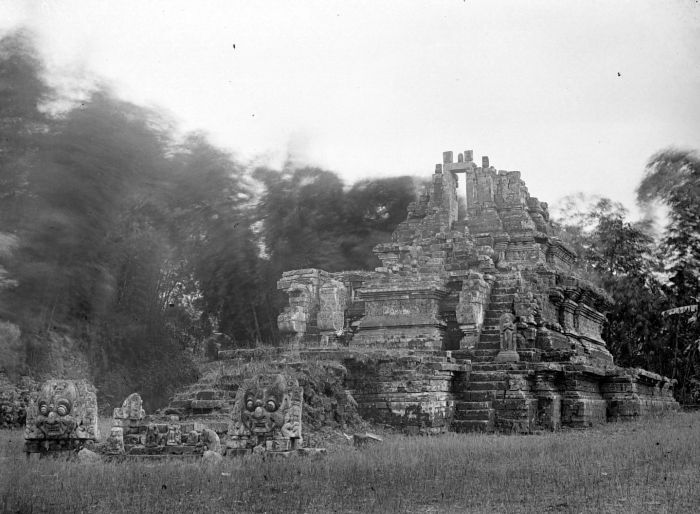Candi Jago on:
[Wikipedia]
[Google]
[Amazon]
 Jago temple (
Jago temple (
 Jago temple (
Jago temple (Indonesian
Indonesian is anything of, from, or related to Indonesia, an archipelagic country in Southeast Asia. It may refer to:
* Indonesians, citizens of Indonesia
** Native Indonesians, diverse groups of local inhabitants of the archipelago
** Indonesian ...
: ''Candi Jago'') is a 13th-century Hindu
Hindus (; ) are people who religiously adhere to Hinduism.Jeffery D. Long (2007), A Vision for Hinduism, IB Tauris, , pages 35–37 Historically, the term has also been used as a geographical, cultural, and later religious identifier for ...
temple
A temple (from the Latin ) is a building reserved for spiritual rituals and activities such as prayer and sacrifice. Religions which erect temples include Christianity (whose temples are typically called churches), Hinduism (whose temples ...
from the Singhasari
Singhasari ( jv, ꦏꦫꦠꦺꦴꦤ꧀ꦱꦶꦔ꧀ꦲꦱꦫꦶ, translit=Karaton Singhasari or , id, Kerajaan Singasari) was a Javanese Hindu kingdom located in east Java between 1222 and 1292. The kingdom succeeded the Kingdom of Kediri as ...
kingdom in East Java, Indonesia, located about 22 km from Malang
Malang (; ) is a landlocked List of regencies and cities of Indonesia, city in the Indonesian Provinces of Indonesia, province of East Java. It has a history dating back to the age of Singhasari, Singhasari Kingdom. It is the second most popul ...
. The Nagarakretagama
The ''Nagarakretagama'' or ''Nagarakṛtāgama'', also known as ''Desawarnana'' or ''Deśavarṇana'', is an Old Javanese eulogy to Hayam Wuruk, a Javanese king of the Majapahit Empire. It was written on lontar as a ''kakawin'' by Mpu Prapan ...
written in 14th century mentioned this temple, as ''Jajaghu'' (English: "majestic"), as one of the temples visited by King Hayam Wuruk
Hayam Wuruk (Sanskrit: हयम् वुरुक्, Kawi: ꦲꦪꦩ꧀ꦮꦸꦫꦸꦏ꧀) (1334–1389), also called Rajasanagara, Pa-ta-na-pa-na-wu, or Bhatara Prabhu after 1350, was a Javanese Hindu emperor from the Rajasa Dynasty and th ...
during his royal tour across East Java.
The Singhasari
Singhasari ( jv, ꦏꦫꦠꦺꦴꦤ꧀ꦱꦶꦔ꧀ꦲꦱꦫꦶ, translit=Karaton Singhasari or , id, Kerajaan Singasari) was a Javanese Hindu kingdom located in east Java between 1222 and 1292. The kingdom succeeded the Kingdom of Kediri as ...
King Vishnuvardhana was deified as Shiva
Shiva (; sa, शिव, lit=The Auspicious One, Śiva ), also known as Mahadeva (; ɐɦaːd̪eːʋɐ, or Hara, is one of the principal deities of Hinduism. He is the Supreme Being in Shaivism, one of the major traditions within Hindu ...
, in the form of Bodhisattva
In Buddhism, a bodhisattva ( ; sa, 𑀩𑁄𑀥𑀺𑀲𑀢𑁆𑀢𑁆𑀯 (Brahmī), translit=bodhisattva, label=Sanskrit) or bodhisatva is a person who is on the path towards bodhi ('awakening') or Buddhahood.
In the Early Buddhist schools ...
Avalokitesvara, here after his death in 1268. The temple's bas-relief
Relief is a sculptural method in which the sculpted pieces are bonded to a solid background of the same material. The term ''relief'' is from the Latin verb ''relevo'', to raise. To create a sculpture in relief is to give the impression that the ...
s depict scenes from the ''Kunjarakarna'', ''Parthayajna'', ''Arjunavivaha'', and ''Krishnayana''.
The name of Adityawarman
Adityawarman (formal regnal name Maharajadiraja Srīmat Srī Udayādityawarma Pratāpaparākrama Rājendra Maulimāli Warmadewa. ) was a king of Malayapura Suvarnabhumi, and is the successor of the Mauli dynasty based on central Sumatra. He was ...
appears in 1343 on an image of the Bodhisattva
In Buddhism, a bodhisattva ( ; sa, 𑀩𑁄𑀥𑀺𑀲𑀢𑁆𑀢𑁆𑀯 (Brahmī), translit=bodhisattva, label=Sanskrit) or bodhisatva is a person who is on the path towards bodhi ('awakening') or Buddhahood.
In the Early Buddhist schools ...
Manjusri
Mañjuśrī (Sanskrit: मञ्जुश्री) is a ''bodhisattva'' associated with '' prajñā'' (wisdom) in Mahāyāna Buddhism. His name means "Gentle Glory" in Sanskrit. Mañjuśrī is also known by the fuller name of Mañjuśrīkumārab ...
.
See also
*Candi of Indonesia
A candi () is a Hindu or Buddhist temple in Indonesia, mostly built during the ''Zaman Hindu-Buddha'' or " Hindu-Buddhist period" between circa the 4th and 15th centuries.
The ''Kamus Besar Bahasa Indonesia'' defines a ''candi'' as an ancient s ...
* Hinduism in Java
Hinduism has historically been a major religious and cultural influence in Java. In recent years, it has also been enjoying something of a resurgence, particularly in the eastern part of the island.
History
Both Java and Sumatra were subject t ...
* Indonesian Esoteric Buddhism
Indonesian Esoteric Buddhism or Esoteric Buddhism in Maritime Southeast Asia refers to the traditions of Esoteric Buddhism found in Maritime Southeast Asia which emerged in the 7th century along the maritime trade routes and port cities of the In ...
* Jawi Temple
* Singhasari temple
Singhasari ( jv, ꦏꦫꦠꦺꦴꦤ꧀ꦱꦶꦔ꧀ꦲꦱꦫꦶ, translit=Karaton Singhasari or , id, Kerajaan Singasari) was a Javanese Hindu kingdom located in east Java between 1222 and 1292. The kingdom succeeded the Kingdom of Kediri as ...
References
Archaeological sites in Indonesia Buildings and structures in East Java Singhasari 13th-century Hindu temples Cultural Properties of Indonesia in East Java {{Asia-archaeology-stub